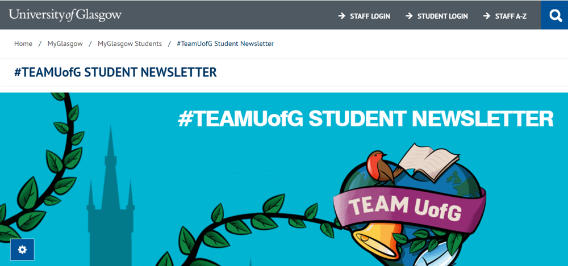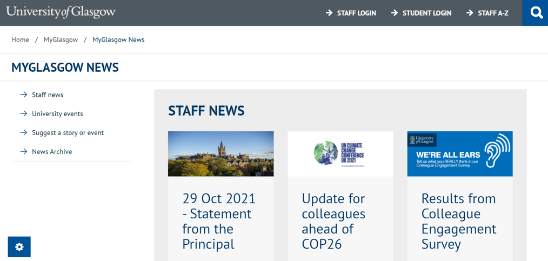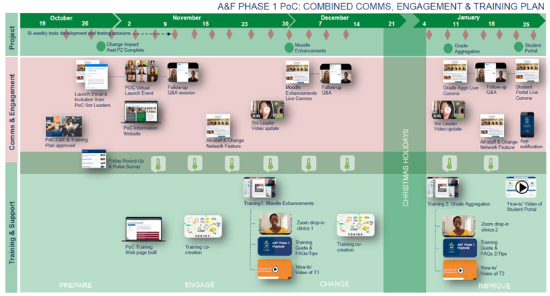
Helpful Information and Guidance
Helpful Information and Guidance
There’s a lot to get right when it comes to creating impactful communications and engagement. So to help you with some of the aspects of creating an amazing plan, we’ve gathered together some helpful information to get you started.
Our Brand
It is important that all of our communications are compliant with our University of Glasgow brand standards. We have access to all the information regarding brand colours, logotypes and fonts through the dedicated Brand Toolkit. Here you will also find guidance to approved photography. We have the ability to use the University’s photography library where you can choose from a variety of subject types.
Our Tone of Voice
The Brand Toolkit also has an extensive guide on tone of voice to be used in University communications. It is vital that we reflect the University’s verbal identity in everything we do. The resources also have a handy Style Guide, which has advice on how to write certain words and phrases, or how to represent numbers and dates.
This guidance should form the backbone of our content, however consideration should be given to the objective of our communications. For example, our tone of voice should provide clear and transparent context if we are asking staff to make a decision. The area of our Communication Brief that will help us, is in our audience ‘Think, Feel, Do’ section.
Writing for the Web
Much of our communication is now via digital channels, and our content has to reflect how our audiences consume information on these platforms. Verbose content will not support comprehension, and is hard to find via search mechanisms in the web environment. Guidance on writing for the web can be found in the Brand Toolkit.
Accessibility
All communications and engagement assets should be assessed for accessibility, so that it is optimally available to users with disabilities who may be using specialist assistive technologies, such as screen readers.
Some helpful pointers:
-Most applications, such as Powerpoint, allow you to review your document for accessibility
-Photographs and diagrams should always have alternative text
-High contrast is best for layouts to allow easy navigation
-Videos should always contain captions
UofG has published its own guidance on document accessibility.
Our Audiences and Channels
Many projects have in scope a complex mixture of stakeholders, so it is vital in any Communications and Engagement approach that we understand this in detail to make sure our approach has the planned impact or outcome.
For example, do we want to start a productive dialogue with our audience, or do we want to simply give them comfort. Each of these objectives will require a distinctive approach, both in channel and content.
The University has a range of channels available for Communications and Engagement, and over the last few years, The Transformation Team has developed deep knowledge of which work best for our core audiences.
Students
Our student-facing communication channels include:
- Student Newsletter
- MyGlasgow Student (portal)
- UofG Life App
- Social media, including Twitter and Instagram
We also engage with Students via the Students’ Representative Council (SRC).

Academic Staff
We communicate and receive feedback from our Academic staff through:
- College/School level committees
- Information presented by Heads of College, School or Deans of Learning and Teaching
- MyGlasgow News
MPA Staff
Our MPA staff engage with a variety of channels including:
- University of Glasgow website
- MyGlasgow Staff (portal)
Microsoft Teams - College/School channels
- MyGlasgow News

Change Network
We manage a network of individuals across the University who wish to engage with, and act as ambassadors for, Change and Transformation content. As a community they prove incredibly helpful in shaping and testing ideas. We have a dedicated newsletter and webpage for this group, and host regular events.
Projects, Programmes and Governance
Large projects or programmes benefit from dedicated space and focus when it comes to communications and engagement. We generally advocate a focused suite of communications to the selected group, including project bulletins, delivery sessions and workshops.
The Senior Management Team, our Transformation board and project boards primarily use board papers and presentations to ensure clear and transparent communications. It is important that these assets are created to ensure comprehension and are built with engagement and accessibility in mind.
The Communications and Engagement Plan
Each significant project or campaign should be underpinned by a comprehensive Communications and Engagement Plan. This plan should contain the following:
- A clear approach or concept, alongside with key brand elements
- A segmented messaging palette which will define the key information for each audience group, and any relevant call-to-action
- An achievable timeline of activity, taking into consideration any complexities with regards to asset creation or the external context
This document should be approved and shared with relevant stakeholders for reference. A summary document can be produced to help everyone stay on track.

Communications Directory
Please contact the below for any other communications requirements
Central communications and public affairs team
External Relations and Marketing
Join the Communication Community of Practice

